Please read the important information regarding these games at the bottom of the page.
DNA - The Double Helix Game - Help
Aim of the game
DNA (deoxyribonucleic acid) is the genetic material in all known living organisms and some viruses. DNA contains two strands wrapped around each other in a helix, and these strands are held in place by four chemicals called bases: adenine (A), guanine (G), cytosine (C) and thymine (T). The bases pair up with each other in a specific manner to form units called base pairs - adenine always pairs with thymine, and cytosine always pairs with guanine.
Your job is to first make exact copies of a double-stranded DNA molecule by correctly matching base pairs to each strand, and to then determine which organism the DNA belongs to.
- For each correct base-pairing you will receive 1 point.
- If you make no base-pairing mistakes you will receive 200 bonus points.
- If you make more than three mistakes on each strand (six mistakes in total), the DNA molecules will be destroyed and you will receive no bonus points.
- If you select the right organism, you will receive 150 bonus points.
- If you choose the wrong organism, you will receive a 20 point fine.
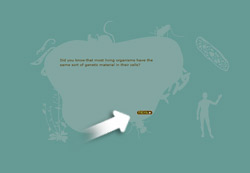
1.
Read the introductory text and click on "Next" to start the game.
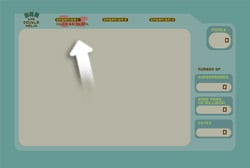
2.
Click on the flashing "Organism 1" button.
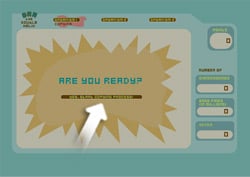
3.
Click on "Yes, start the copying process".
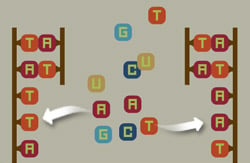
4.
ake copies of both strands of the DNA molecule by dragging and dropping the correct bases onto each DNA strand to form matching base pairs. Remember, A (Adenine) always pairs with T (Thymine), and G (Guanine) always pairs with C (Cytosine). U (Uracil) is not used in DNA molecules.

5.
Click on "Next".

6.
If you make more than three mistakes (mutations) on each strand, the DNA molecules will be destroyed and you will not receive any bonus points. If you make less than three mistakes on each strand, the DNA molecules will be replicated. If you make no mistakes at all, you will receive 200 bonus points.
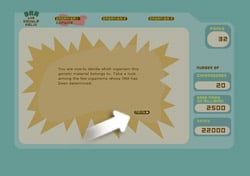
7.
Click on "Next".
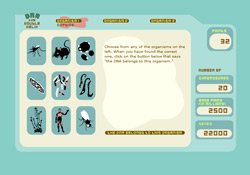
8.
Click on the small images to read about the nine different organisms. Compare the facts given in the text with the facts in the right-hand menu (Number of Chromosomes, Number of Base Pairs, Number of Genes). When you have decided which organism corresponds to the facts available, click on "The DNA belongs to this organism". If you're right, you'll be awarded 150 bonus points.
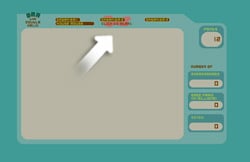
9.
Continue the game for two more organisms to see how many points you can earn!
Key
Malaria mosquito: 5 chromosomes, 278 million base pairs, 13,700 genes
House mouse: 20 chromosomes, 2,500 million base pairs, 22,000 genes
Bakers' yeast: 16 chromosomes, 11.7 million base pairs, 6,300 genes
Mycobacterium tuberculosis: 1 chromosome, 4.4 million base pairs, 3,900 genes
Escherichia coli bacteria: 1 chromosome, 5 million base pairs, 4,300 genes
Malaria parasite: 14 chromosomes, 22.7 million base pairs, 5,300 genes
Thale cress: 5 chromosomes, 125 million base pairs, 25,000 genes
Human being: 46 chromosomes, 3,000 million base pairs, 34,000 genes
Fruit fly: 8 chromosomes, 180 million base pairs, 13,500 genes
(These facts were collected in 2003, today the number of genes in humans is considered to be about 20,000.)
Copyright © Nobel Media AB 2018
MLA style: "DNA - The Double Helix - Help". Nobelprize.org. Nobel Prize Outreach AB 2022. <http://nobel-external-educationalgames-app.azurewebsites.net/educational/medicine/dna_double_helix/help.php?objectname=%2Feducational%2Fmedicine%2Fdna_double_helix%2F>
About the educational games
The educational games are based on Nobel Prize awarded achievements and were produced between 2001 and 2012. Most games have not been updated since production (including potential scientific facts changes) and are provided here on an 'as is' basis by popular demand.
Some of the games run in modern browsers without the need of any plugin (either as a new version or using Ruffle), but many of the games still require Adobe Flash Player. Flash is an old technology that has reached end of life. These games will no longer work without a dedicated setup. If you are depending on these games in your profession, please advice your local IT support. We do not have the resources to provide support.
We are working on supporting more games without Flash.